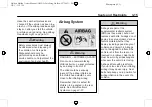
Black plate (27,1)
Holden Malibu Owner Manual (GMNA-Localizing-Holden-9272603) - 2015 -
CRC - 11/21/14
Seats and Restraints
3-27
Selection of a particular restraint
should take into consideration not
only the child's weight, height, and
age but also whether or not the
restraint will be compatible with the
vehicle in which it will be used.
For most basic types of child
restraints, there are many different
models available. When purchasing
a child restraint, be sure it is
designed to be used in your vehicle.
The restraint manufacturer's
instructions should state the weight
and height limitations for a particular
child restraint.
{
Warning
To reduce the risk of neck and
head injury during a crash, infants
need complete support. In a
crash, if an infant is in a
rear-facing child restraint, the
crash forces can be distributed
across the strongest part of an
infant's body, the back and
(Continued)
Warning (Continued)
shoulders. Infants should always
be secured in rear-facing child
restraints.
{
Danger
A young child's hip bones are still
so small that the vehicle's regular
seat belt may not remain low on
the hip bones, as it should.
Instead, it may settle up around
the child's abdomen. In a crash,
the belt would apply force on a
body area that is unprotected by
any bony structure. This alone
could cause serious or fatal
injuries. To reduce the risk of
serious or fatal injuries during a
crash, young children should
always be secured in appropriate
child restraints.
Child Restraint Systems
We recommend a child restraint
system that is tailored specifically to
the vehicle.
When a child restraint system is
being used, pay attention to the
following usage and installation
instructions and also those supplied
with the child restraint system.
Always comply with local or national
regulations.
















































